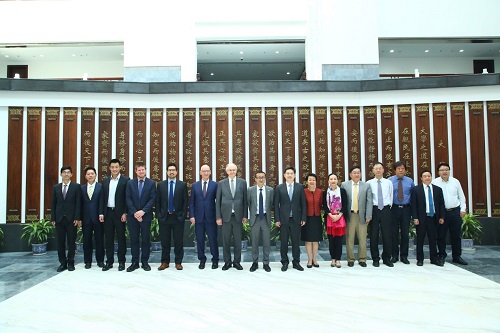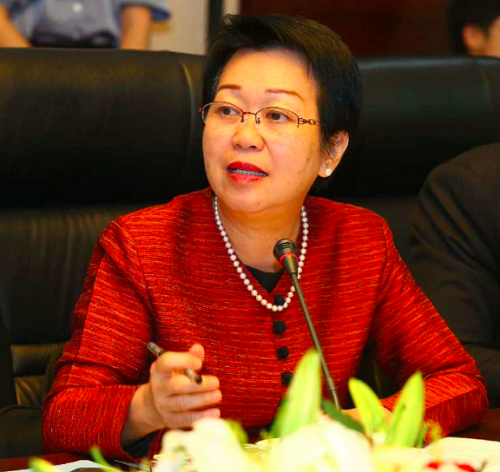 Research Update
Research Update
28
SepOn September 24th, on the occasion of the Mid-Autumn Festival, the Sino-Australia Strategic Economic Dialogue and the “Belt and Road” Investment-Friendly Index Conference, jointly organized by National Academy of Development and Strategy of Renmin University of China and the Australian National University East Asia Economy Institute and supported by International Cooperation Center of National Development and Reform Commission, was held in Renmin University of China. Officials and experts from the Renmin University of China, the Australian National University, the National Development and Reform Commission International Cooperation Center, the Asian Infrastructure Investment Bank Investment Agency and other institutions gathered to discuss in depth the opportunities for cooperation between China and Australia under the BRI, the prospects and implementation of the BRI on a global scale. The “Belt and Road” Investment-Friendly Index 2018 report prepared by the project team of the BRI Research Center of NADS was released at the conference.

The conference was presided over by Professor Xu Qinhua, Deputy Dean of NADS and Director of BRI Research Center.
Liu Yuanchun, Vice President of Renmin University of China, said in his speech that Renmin University of China aims to build a "people-satisfying, world-class" university, and continuously enhances international exchanges and is committed to building a high-level international and open academic platform. The “Belt and Road Initiative” is a positive exploration of China's new model of international cooperation. RUC should strive to exert a strong comprehensive academic advantage in humanities and social sciences, integrate the international vision of top universities in various countries, and jointly promote the further development of the BRI. Renmin University of China has a deep friendship with the Australian National University. At the moment when the BRI is on the fifth anniversary, the “Belt and Road” Investment-Friendly Index released this time is the first index of this type in China. It has strong timeliness and necessity and has important reference significance. Under the principle of mutual benefit and win-win of BRI, NADS, as a national high-end think tank, should portray the environment and prospects of investment cooperation and provide it to relevant social and political elites so that they can make correct decisions.

Peter Drysdale, Honorable Retired Professor of the Crawford School of Public Policy at the Australian National University, Director of the East Asia Forum and the East Asian Economic Research Institute, expressed his appreciation for the scientific cooperation between the two universities, analyzed in depth his understanding of the BRI, the challenges and changes encountered in its implementation. He affirmed the research results of RUC on the “Belt and Road” Investment-Friendly Index and the role of this achievement in promoting regional and global research institutions to help economic development.

Huang Yong, Director of the International Cooperation Center of the National Development and Reform Commission, believes that the “Belt and Road” Investment-Friendly Index has an important guiding role in the policy design and deepening implementation of BRI. He pointed out that it is necessary to profoundly understand the macro background of the BRI and the trend of the times. With the opportunities and challenges coexisting in the world today, a new round of scientific and technological revolutions and industrial changes are poised for growth, and the demands of development of various countries are very strong. However, the recovery of the world economy is still difficult and tortuous. Many countries still face development imbalances, governance dilemmas, fairness deficits and other outstanding issues. In this context, the vast number of developing countries' demands for economic independence and national rejuvenation through accelerated industrialization and urbanization are urgent, and the concept of China's “Belt and Road” construction provides a direction for global governance. The construction of “One Belt One Road” is an important carrier of global economic integration. It will promote the cooperation with overseas industrial parks in international capacity field, with the quality of cooperation increasingly enhanced. For the prospect of BRI construction, he believes that we should pay attention to five aspects: mutual benefit and win-win, pragmatic cooperation, common development, benefiting people's livelihood, and focusing on innovation.

Supee Teravaninthorn, Director of the Bank and Investment Bureau of AIIB, believes that Asia's economy is very important in the global economy. As far as the growth of emerging countries is concerned, Asia has now become the driver of international economic growth. It is predicted that the growth of the international economy will still come from Asia in the coming decades. Infrastructure construction itself helps sustain growth and address bottlenecks in development. The rapid development of urbanization in Asia has created a great demand for sustainable development. The current gap between infrastructure needs and funding in Asia continues to require more effective ways to share resources. Economic interconnection will promote a further increase in market volume. In this context, the “Belt and Road” can become a new paradigm of regional integration to achieve economic connectivity and reduce regional barriers. In the face of the challenges of infrastructure construction, the AIIB has achieved gratifying results. If it can be effectively managed in the future, the financial support of the AIIB will greatly help narrow the financing gap.

Peter Drysdale, Director of East Asia Economic Research Institute of Australian National University and Xu Qinhua, Deputy Dean of NADS concluded the meeting. They affirmed the results of the discussions at this meeting, summarized the opportunities and challenges faced in the implementation of the BRI, reviewed the suggestions and reflections put forward by the participants, and expressed their expectations for further cooperation and exchanges between the two sides.